Items
Tag
groundwater management
-
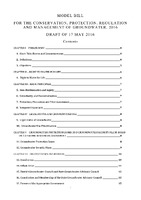 MODEL BILL FOR THE CONSERVATION, PROTECTION, REGULATION AND MANAGEMENT OF GROUNDWATER The 2016 Model Bill for the Conservation, Protection, Regulation, and Management of Groundwater aims to address the ongoing groundwater crisis in India, characterized by over-extraction and contamination, which threatens drinking water security and livelihoods. It recognizes groundwater as a common pool resource and establishes a legal framework to ensure equitable access and sustainable management through local governance structures like Gram Panchayats, urban committees, and councils. The Bill emphasizes the right to safe water, prioritizes groundwater for basic human needs, and mandates comprehensive planning, monitoring, and regulatory measures to protect water resources while promoting conservation and community participation.
MODEL BILL FOR THE CONSERVATION, PROTECTION, REGULATION AND MANAGEMENT OF GROUNDWATER The 2016 Model Bill for the Conservation, Protection, Regulation, and Management of Groundwater aims to address the ongoing groundwater crisis in India, characterized by over-extraction and contamination, which threatens drinking water security and livelihoods. It recognizes groundwater as a common pool resource and establishes a legal framework to ensure equitable access and sustainable management through local governance structures like Gram Panchayats, urban committees, and councils. The Bill emphasizes the right to safe water, prioritizes groundwater for basic human needs, and mandates comprehensive planning, monitoring, and regulatory measures to protect water resources while promoting conservation and community participation. -
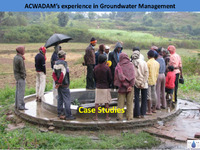 Experience in Groundwater Management Case Studies_ACWADAM ACWADAM's groundwater management initiatives highlight successful community-based strategies in three villages: Pondhe, Muthalane, and Randullabad. In Pondhe, a formal water user group system is established to manage irrigation solely through dug wells, with regulations to prevent overexploitation and ensure equitable water distribution. Muthalane, a tribal region, focuses on community participation and sustainable practices, with new wells and repairs planned to enhance water access. Randullabad employs effective monitoring and management of its aquifers, promoting sustainable irrigation practices. Overall, these case studies demonstrate the importance of community engagement and strategic planning in groundwater management.
Experience in Groundwater Management Case Studies_ACWADAM ACWADAM's groundwater management initiatives highlight successful community-based strategies in three villages: Pondhe, Muthalane, and Randullabad. In Pondhe, a formal water user group system is established to manage irrigation solely through dug wells, with regulations to prevent overexploitation and ensure equitable water distribution. Muthalane, a tribal region, focuses on community participation and sustainable practices, with new wells and repairs planned to enhance water access. Randullabad employs effective monitoring and management of its aquifers, promoting sustainable irrigation practices. Overall, these case studies demonstrate the importance of community engagement and strategic planning in groundwater management. -
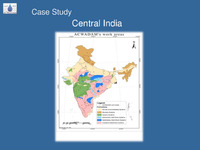 Case Study Central India The project in Central India, led by the Advanced Center for Water Resources Development and Management and Samaj Pragati Sahayog, focuses on sustainable groundwater management in Bagli Tehsil, where reliance on groundwater is increasing but data for effective planning is lacking. It involves gathering hydrogeological data and community participation to create a comprehensive understanding of groundwater resources. This includes monitoring water levels, quality, and recharge rates across various aquifers, developing protocols for responsible water use, and implementing measures to protect recharge areas and regulate abstraction. The goal is to ensure equitable management of groundwater resources amid rising demand.
Case Study Central India The project in Central India, led by the Advanced Center for Water Resources Development and Management and Samaj Pragati Sahayog, focuses on sustainable groundwater management in Bagli Tehsil, where reliance on groundwater is increasing but data for effective planning is lacking. It involves gathering hydrogeological data and community participation to create a comprehensive understanding of groundwater resources. This includes monitoring water levels, quality, and recharge rates across various aquifers, developing protocols for responsible water use, and implementing measures to protect recharge areas and regulate abstraction. The goal is to ensure equitable management of groundwater resources amid rising demand. -
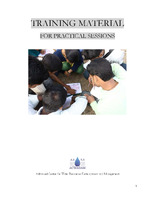 TRAINING MATERIAL FOR PRACTICAL SESSIONS Advanced Center for Water Resources Development and Management The training material for practical sessions at the Advanced Center for Water Resources Development and Management covers essential topics in hydrogeology and watershed management. Key subjects include measurement units, toposheet reading, drainage analysis, and the integration of weather data for groundwater studies. Participants will learn about groundwater contour mapping, the use of Piper diagrams for water quality analysis, and methods for measuring spring discharge and water quality. The curriculum also emphasizes practical fieldwork and data collection, culminating in a socio-hydrological survey aimed at developing effective water management plans for local communities.
TRAINING MATERIAL FOR PRACTICAL SESSIONS Advanced Center for Water Resources Development and Management The training material for practical sessions at the Advanced Center for Water Resources Development and Management covers essential topics in hydrogeology and watershed management. Key subjects include measurement units, toposheet reading, drainage analysis, and the integration of weather data for groundwater studies. Participants will learn about groundwater contour mapping, the use of Piper diagrams for water quality analysis, and methods for measuring spring discharge and water quality. The curriculum also emphasizes practical fieldwork and data collection, culminating in a socio-hydrological survey aimed at developing effective water management plans for local communities. -
 MANAGING THE UMBARI SPRINGS:A Hydrogeological approach The management of the Umbari springs, crucial freshwater sources for Chorage and Jadhav Umbari villages, is increasingly challenged by changing rainfall patterns and population growth. The springs are fed by shallow aquifers in a region characterized by Deccan basalts and laterite, and their discharge is affected by the geology and seasonal precipitation. A hydrogeological study highlighted the need for a community-based approach to sustainably manage these springs, including soil conservation, repairing distribution systems, and monitoring water quality. Recommendations also suggest regulating groundwater extraction and protecting recharge areas to ensure equitable access and long-term viability of water resources.
MANAGING THE UMBARI SPRINGS:A Hydrogeological approach The management of the Umbari springs, crucial freshwater sources for Chorage and Jadhav Umbari villages, is increasingly challenged by changing rainfall patterns and population growth. The springs are fed by shallow aquifers in a region characterized by Deccan basalts and laterite, and their discharge is affected by the geology and seasonal precipitation. A hydrogeological study highlighted the need for a community-based approach to sustainably manage these springs, including soil conservation, repairing distribution systems, and monitoring water quality. Recommendations also suggest regulating groundwater extraction and protecting recharge areas to ensure equitable access and long-term viability of water resources. -
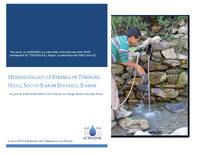 Hydrogeological assessment of Tendong Hills Region The report by ACWADAM outlines the hydrogeological assessment of the Tendong Hill region in South Sikkim, as part of the Village Water Security Plan (VWSP) development project in collaboration with RMDD and GIZ. It highlights the intricate relationship between the diverse rock types and structures in the Himalayas and their impact on the hydrogeological environment. The assessment reveals that the local aquifers are often discontinuous and can vary significantly in size and discharge, leading to challenges in water management for surrounding villages. Additionally, the report emphasizes that existing watershed development programs often overlook geological factors, risking project efficacy and sustainability. Key findings from the assessment indicate that springs in the Tendong Hills are primarily influenced by geological structures, including faults and fractures that dictate spring locations and discharge behaviors. The study identifies crucial recharge areas for these springs and underscores the necessity of integrating geological insights into water management strategies. ACWADAM's efforts include monitoring spring discharge and water quality, along with community capacity building for better management practices. The Dhara Vikas project, which aims to conserve springs, relies on ACWADAM's hydrogeological expertise to inform its methodologies. In conclusion, the report suggests a regional implementation plan to enhance water security in the Tendong Hill area, particularly for villages facing water scarcity. The proposed VWSP will address specific village needs while incorporating a holistic understanding of the local hydrogeological context. By engaging local communities and leveraging scientific research, the project aims to create sustainable water management practices that are resilient to both climatic and anthropogenic pressures, ultimately fostering greater water security for the region's inhabitants.
Hydrogeological assessment of Tendong Hills Region The report by ACWADAM outlines the hydrogeological assessment of the Tendong Hill region in South Sikkim, as part of the Village Water Security Plan (VWSP) development project in collaboration with RMDD and GIZ. It highlights the intricate relationship between the diverse rock types and structures in the Himalayas and their impact on the hydrogeological environment. The assessment reveals that the local aquifers are often discontinuous and can vary significantly in size and discharge, leading to challenges in water management for surrounding villages. Additionally, the report emphasizes that existing watershed development programs often overlook geological factors, risking project efficacy and sustainability. Key findings from the assessment indicate that springs in the Tendong Hills are primarily influenced by geological structures, including faults and fractures that dictate spring locations and discharge behaviors. The study identifies crucial recharge areas for these springs and underscores the necessity of integrating geological insights into water management strategies. ACWADAM's efforts include monitoring spring discharge and water quality, along with community capacity building for better management practices. The Dhara Vikas project, which aims to conserve springs, relies on ACWADAM's hydrogeological expertise to inform its methodologies. In conclusion, the report suggests a regional implementation plan to enhance water security in the Tendong Hill area, particularly for villages facing water scarcity. The proposed VWSP will address specific village needs while incorporating a holistic understanding of the local hydrogeological context. By engaging local communities and leveraging scientific research, the project aims to create sustainable water management practices that are resilient to both climatic and anthropogenic pressures, ultimately fostering greater water security for the region's inhabitants.